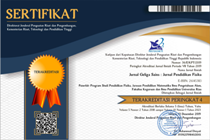Development of Test Instruments Based on Problem Solving at The High School Level
Abstract
Research on the development of problem solving-based test instruments at the high school level was carried out aimed at measuring student’s problem solving abilities according to the problem solving aspect of Polya and knowing the feasibility of test instruments in terms of validity, reliability, discriminatory power, and level of difficulty. This type of research is research and development with the ADDIE model namely Analysis, Design, Development, Implementation, and Evaluation. The research was conducted at Al Ulum Terpadu Islamic High School Medan with the research subject being XII MIA, totaling 15 students for small groups and 35 students for large groups. The results of the expert validation stated that the 15 questions developed were in the very feasible category. The results of the small group of 15 questions obtained 10 valid questions with a reliability value of 0.89 in the high category, the difficulty level of the items was 0.46-0.95 and the discriminating power of the items was 0.03-0.71. The results of the large group obtained 10 questions in the valid category and a reliability value of 0.93 in the high reliability category, the difficulty level of the items was 0.29-0.54 and the different power of the items was 0.13-0.55.
Keywords
Full Text:
PDF (Bahasa Indonesia)References
Arikunto, S. (2018). Dasar-dasar evaluasi pendidikan (3rd ed.). Jakarta: PT Bumi Aksara.
Avista, S. F., & Sabani. (2022). Pengembangan instrumen tes berbasis pemecahan masalah pada materi fluida dinamis di SMA. Jurnal Inovasi Pembelajaran Fisika, 3, 70-78.
Ayumniyya, L., & Setyarsih, W. (2021). Profil kemampuan berpikir tingkat tinggi siswa SMA dalam pemecahan masalah pada materi hukum newton. Inovasi Pendidikan Fisika, 1(1), 50–58.
Branch, R. M. (2009). Instructional Design: The ADDIE Approach. New York: Springer Science.
Erfan, M., & Ratu, T. (2018). Pencapaian HOTS (Higher Order Thinking Skills) mahasiswa Program Studi Pendidikan Fisika FKIP Universitas Samawa. Jurnal Pendidikan Fisika Dan Teknologi, 4(2), 208. Retrieved from https://doi.org/10.29303/jpft.v4i2.831
Fanani, M. Z. (2018). Strategi Pengembangan Soal Higher Order Thinking Skill (HOTS) dalam kurikulum 2013. Journal of Islamic Religious Education, 2(1), 57–76.
Fitrianty, F., Yunita, A., & Juwita, R. (2022). Pengembangan instrumen tes kemampuan pemecahan masalah matematika di SMP Negeri 12 Padang. Lattice Journal : Journal of Mathematics Education and Applied, 2(1), 91. Retrieved from https://doi.org/10.30983/lattice.v2i1.5337
Hidayat, S. R., Setyadin, A. H., Hermawan, Kaniawati, I., Suhendi, E., Siahaan, P., & Samsudin, A. (2017). Pengembangan instrumen tes keterampilan pemecahan masalah pada materi getaran, gelombang, dan bunyi. Jurnal Riset Dan Pengembangan Pendidikan Fisika, 3, 157–166.
Kurniawan, B. R., & Taqwa, M. R. A. (2018). Pengembangan instrumen tes kemampuan pemecahan masalah fisika pada materi listrik dinamis. Jurnal Pendidikan, 3(11), 1451-1457.
Lestari, P. E., Purwanto, A., & Sakti, I. (2019). Pengembangan instrumen tes keterampilan pemecahan masalah pada konsep usaha dan energi di SMA. Jurnal Kumparan Fisika, 2(3), 161-168.
Malik, A., Rosidin, U., & Ertikanto, C. (2018). Pengembangan instrumen asesmen HOTS fisika SMA menggunakan model inkuiri terbimbing. Jurnal Lentera Pendidikan Pusat Riset LPPM UM METRO, 3(1), 11-25.
OECD. (2019). PISA 2018 Results in Focus. New York: Columbia University.
Pertiwi, C. M., Muliyati, D., & Serevina, V. (2016). Rancangan tes dan evaluasi fisika yang informatif dan komunikatif pada materi kinematika gerak lurus. Jurnal Riset Dan Pengembangan Pendidikan Fisika, 2(1), 81–88.
Polya, G. (2004). How to solve it a new aspect of mathematical method. United States of America: Princeton University Press.
Sani, R. A. (2019). Pembelajaran berbasis HOTS (Higher Order Thinking Skills). Tangerang: Tsmart Printing.
Yuliantaningrum, L., & Sunarti, T. (2020). Pengembangan instrumen soal hots untuk mengukur keterampilan berpikir kritis, berpikir kreatif, dan pemecahan masalah materi gerak lurus pada murid SMA. Jurnal Inovasi Pendidikan Fisika, 9(2), 76–82.
DOI: http://dx.doi.org/10.31258/jgs.11.1.11-19
Refbacks
- There are currently no refbacks.
Copyright (c) 2023 ditya lufita, Rita Juliani

This work is licensed under a Creative Commons Attribution 4.0 International License.
Jurnal ini terdaftar dan terindeks pada:
- Crossref
- Google Scholar
- Crossref
- Garuda
- Sinta
- Researchgate
- Dimensions
- Base
- Scilit
- OneSearch
- Road
- CiteFactor
- ResearchBib
- WorldCat



















